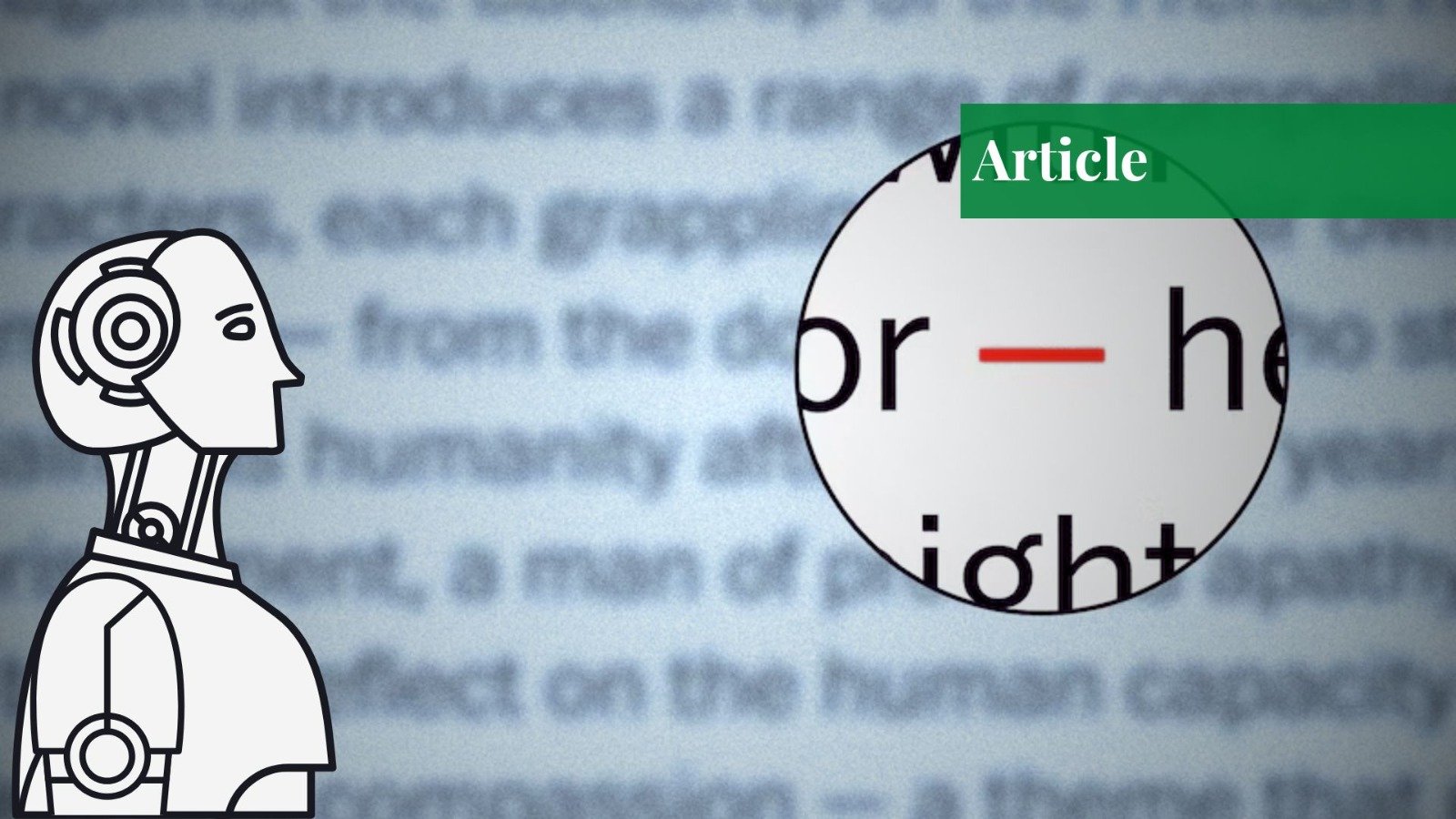The em dash has become a shorthand for “AI writing.” Writers and readers alike suspect, if not assume, that if a text is rife with dashes, it could only have been generated by a model. Why? Large language models, designed to create fluid, probabilistic prose, gravitate handily toward the em dash as a punctuation mark. It is quick, flexible, and lends itself to transitions while avoiding the precision required of semicolons and parentheses. But this suspicion gestures to something greater than just punctuation. Our anxiety about the em dash as an indication of machine-authored text points to a greater cultural anxiety about the boundaries of human voice and machinic text—whether we can still apprehend authenticity and which small typographical “tells” we can prove.
A Brief History of a Flexible Mark
The em dash—named that for being the same width as an “m”—is a relative newcomer to the history of writing. Classical manuscripts relied much more on spacing, rhythm, and other rhetorical devices to direct reading, rather than punctuation. For example, ancient Greek and Latin manuscripts used scriptio continua, a continuous flow of letters all written together with no spacing or punctuation, which expected a reader to intuit how words connected through cadence and context to construct meaning.
The mechanization of printing in the late Renaissance and early modern era provided a means for punctuation to become visible and necessary. From the 16th to 17th centuries, printers began experimenting with a range of horizontal marks—the hyphen (-), the en dash (–), and the decidedly modern look of the em dash (—) to denote tonal shifts and interruptions in thought. In 1683, the typographer Joseph Moxon formally mentions the dash in Mechanick Exercises on the Whole Art of Printing; it was around this time that it began to appear in type and English print as simply a “longer pause.”
By the 18th century, writers like Laurence Sterne were already using it for comic and expressive purposes. Sterne’s Tristram Shandy (1759–67) regards the dash as a tool of disruption—as a typographic performance of interruption, digression, and immediacy—as a denier of the linear logic of Enlightenment prose. It became a mark of resistance to nothing less than the uniformity of print itself.
In the century to follow, the dash made even greater symbolic achievements. Many Romantic and Victorian writers used it to signal emotional excess or an incompleteness of thought and to represent the permeability of mind and page. With dashes, Emily Dickinson’s manuscripts turned punctuation into poetics: dashes denote structure, not decoration, articulating conditions of breath, of hesitation, and textures of interiority. Early editors, misreading Dickinson’s style as idiosyncratic, disrupted her dashes with commas and periods in a misguided attempt to “discipline” her syntax, thinking it would show a lack of refinement. Critics later acknowledged that her dashes were essential to her philosophy of language: they represented thought in motion, meaning that it resists closure.
The process of domestication observed with the em dash transpires in tandem with larger cultural shifts. Writing became a professional and institutional activity, and style guides started to regulate its use. In Chicago, the style manual permitted its usage but admonished excess; The Associated Press Stylebook limited use to abrupt shifts in tone or structure; and Strunk & White recommended dashes should be used “sparingly,” suggesting they reveal laziness or evasion.
These rules weren’t simply grammatical; they were ideological. They reflect a cultural hierarchy in clarity versus ambiguity and control versus spontaneity. The semicolon communicated rational order, while the colon communicated hierarchy, but the dash was a mark of impulse, intuition, and speech. The dash was equally situated between orality and literacy—too conversational for scholarly writing and too fluid for respectable writing.
Why Machines Love the Dash
The em dash is not just a stylistic benefit for artificial intelligence—it is also competitively computational. To wrap our minds around why, we must first understand how Large Language Models (LLMs) “think.” Human writers compose via intention, fellow syntax, and sense; machines compose via probability. They do not generate meaning; they make predictions.
All large LLMs, such as GPT, Claude, and Gemini, are based on training over vast corpora—thousands of trillions of words scraped from books, websites, or digital archives. During training, the model processes each fragment of text as a token, a unit that could be a word, part of a word, or punctuation. The task is deceptively simple: predict the next token given the previous tokens. Repeating this task across billions of examples, the model begins to learn statistical correlations—some words appear more frequently than others, commas often appear before conjunctions, exclamation points often co-occur with a relevant emotion, and so forth—not necessarily meaning.
In this context, punctuation is not an aesthetic choice; it is a statistical occurrence. The em dash does not appear from stylistic whim but rather as a highly likely component—a safe, multi-purpose symbol that routinely sits between dependent thoughts. Distributed across the oceans of digital text that circulate through these models are em dashes, sooner or later expressed in a wide variety of functions: journalism, blog posts, contemporary essays, creative nonfiction, and even Reddit threads and Medium posts. What it means for a marker to be at home in 21st-century prose is that, for a model that has been trained to reproduce human behaviors, the dash starts to act as a universal solvent—a marker that “works” in just about any setting.
The effects have demonstrable behavioral ramifications. For example, analyses of model outputs (and imitative behaviors) undertaken at the Allen Institute for AI and at OpenAI in interpretability work indicate that LLMs take on behavioral patterns that show systematic overproduction of em dashes and ellipses in open-domain writing. The reason is a function of the loss function—the mathematical measure of what is penalized, or not, for improbable outcomes. Because the dash is allowed to occur among clauses in all manner of patterns, it maintains a high probability. Dashes are rarely “wrong.” They allow the model to maintain grammatical flow without entering into an exact logical arrangement.
When people are unsure, they stop; when machines are unsure, they generate—and the dash is how they hide uncertainty. It is punctuation as probabilistic camouflage.
Think about the alternatives: a colon implies that an explanation follows, a semicolon suggests that a logical relationship exists, and a comma implies continuity. Each of these alternatives requires the model to encode relationships of causality, contrast, or sequence—relationships that the model does not actually encode. The em dash, on the other hand, is noncommittal. The em dash can signal relationships without committing to a type of relationship. It can imply emphasis, hesitation, interruption, or conclusion—all at once. For a predictive system, ambiguity is a gift.
So, the dash serves as what computational linguists might refer to as a “syntactic wildcard.” Without losing fluency, it does not require clarity of meaning. Where a human would agonize over structure—”Should I separate these clauses with a colon or a semicolon?” The model bypasses the stage of reasoning entirely with a dash. It is punctuation for avoidance—a bridge over uncertainty.
This pattern also reflects the cultural data read by the machine itself. LLMs do not develop in a vacuum; they are trained on the Internet—managing billions of pages from journalism, social media, threads, blogs, and more. Studies looking into the corpora used to train generative models, such as Common Crawl and The Pile, have shown that the majority of text data used to train generative systems is informal online writing. And online writing has its own style/rhythm of writing—short paragraphs, conversational voice, and a tendency to overuse punctuation that mimics voice—in particular, the em dash.
Linguistic studies of digital writing confirm this shift in writing style. The em dash occurs around five times more frequently in contemporary English prose than it did in print periodicals from the 1950s. Writings in newsletters, personal essays, and publications employ the em dash as a primary substitute for commas, colons, and parentheses—basically a style point of reference to determine immediacy and thought in motion. For algorithms trained on such data, the em dash is statistically ubiquitous, a symbol of fluency knitted into the fabric of modern authorship. The machine mimics not only our vocabulary but also our habits of punctuation, i.e., our inclination to syntactically provide a performance of spontaneity.
From a computational perspective, the model’s preference for the em dash is perfectly logical. For the system, it is a highly effective connective device—high probability, low incidence, and fully adaptable to the context. The dash allows the model to maintain coherence even when it has little understanding of semantics. Culturally, however, this efficiency becomes almost poetic. The em dash—once the visible remnant of uncertainty in human thought—is a perfect representation of synthetic fluency. It spans the gulf between probability and prose, reducing computational hesitation into stylistic dexterity.
Conclusion
The em dash is more than a piece of punctuation; it is a piece of evolution—both linguistic and technological. Its emergence is an imprint of the digital era’s obsession with immediacy and its desire to experience uninterrupted continuity. In grappling with billions of lines of human text, AI has not only absorbed our grammar but also our pause—the em dash as our communal pulse, our collective breath, in textuality. The machine did not arrive at this punctuation by accident, as its statistical analysis was paved by the probability of humans’ most expressive proclivities, or rather, the punctuation that connects the most fragments of thought in the online era.
Though this provenance suggests something troubling—that the most “human” properties of a language are the easiest to mechanize. The dash—once a remnant of indecision—is now a symbol of mechanized fluency. What once was hesitation now, in fact, is automation.
Ultimately, it is not the em dash that we suspect. It is the authorship of the product—an underlying fear that the distinction between human agency and machination has been flattened to the point that it is indistinguishable. But maybe this is the future of writing—not in a race to guard the boundaries of language, but rather in the acknowledgment that even our pauses, our breaks, and our breaths—can be read, learned, and returned to us by the systems we employ.
If you want to submit your articles and/or research papers, please visit the Submissions page.
To stay updated with the latest jobs, CSS news, internships, scholarships, and current affairs articles, join our Community Forum!
The views and opinions expressed in this article/paper are the author’s own and do not necessarily reflect the editorial position of Paradigm Shift.
Momina Areej is currently pursuing an MPhil in Clinical Pharmacy Practice. With a passion for writing, she covers diverse topics including world issues, literature reviews, and poetry, bringing insightful perspectives to each subject. Her writing blends critical analysis with creative expression, reflecting her broad interests and academic background.



